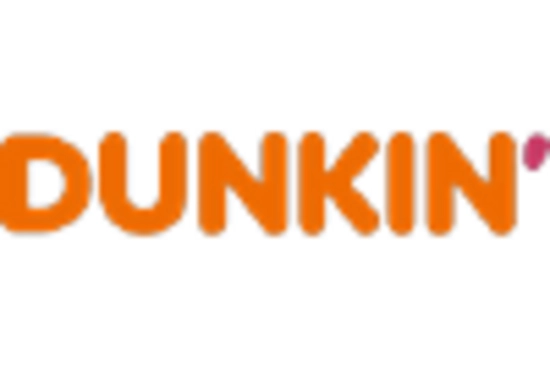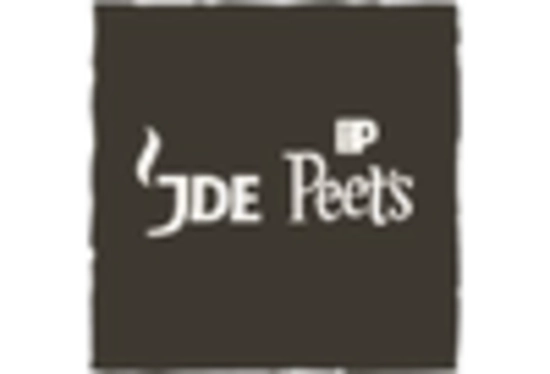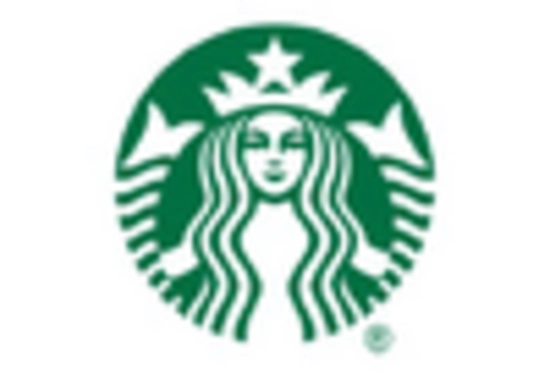-
EXECUTIVE SUMMARY
-
MARKET INTRODUCTION
-
Definition
-
Scope of the Study
- Research Objective
- Assumptions
- Limitations
-
RESEARCH METHODOLOGY
-
Overview
-
Data Mining
-
Secondary Research
-
Primary Research
- Primary Interviews and Information Gathering Process
- Breakdown of Primary Respondents
-
Forecasting Modality
-
Market Size Estimation
- Bottom-Up Approach
- Top-Down Approach
-
Data Triangulation
-
Validation
-
MARKET DYNAMICS
-
Overview
-
Drivers
-
Restraints
-
Opportunities
-
MARKET FACTOR ANALYSIS
-
Value Chain Analysis
-
Porter’s Five Forces Analysis
- Bargaining Power of Suppliers
- Bargaining Power of Buyers
- Threat of New Entrants
- Threat of Substitutes
- Intensity of Rivalry
-
COVID-19 Impact Analysis
- Market Impact Analysis
- Regional Impact
- Opportunity and Threat Analysis
-
GLOBAL FOODSERVICE COFFEE MARKET, BY TYPE
-
Overview
-
Takeaway/Delivery
-
Dine-in
-
GLOBAL FOODSERVICE COFFEE MARKET, BY END-USER
-
Overview
-
Coffee Shops/Chains
-
Bakery Shops
-
Others
-
GLOBAL FOODSERVICE COFFEE MARKET, BY REGION
-
Overview
-
North America
- U.S.
- Canada
-
Europe
- Germany
- France
- U.K
- Italy
- Spain
- Rest of Europe
-
Asia-Pacific
- China
- India
- Japan
- South Korea
- Australia
- Rest of Asia-Pacific
-
Rest of the World
- Middle East
- Africa
- Latin America
-
COMPETITIVE LANDSCAPE
-
Overview
-
Competitive Analysis
-
Market Share Analysis
-
Major Growth Strategy in the Global Foodservice Coffee Market,
-
Competitive Benchmarking
-
Leading Players in Terms of Number of Developments in the Global Foodservice Coffee Market,
-
Key developments and Growth Strategies
- New TYPE Launch/End-user Deployment
- Merger & Acquisitions
- Joint Ventures
-
Major Players Financial Matrix
- Sales & Operating Income, 2022
- Major Players R&D Expenditure. 2022
-
COMPANY PROFILES
-
Starbucks Corporation (U.S.)
- Company Overview
- Financial Overview
- Type Offered
- Key Developments
- SWOT Analysis
- Key Strategies
-
The J.M Smucker Company (U.S.)
- Company Overview
- Financial Overview
- Type Offered
- Key Developments
- SWOT Analysis
- Key Strategies
-
Costa Limited (U.K.)
- Company Overview
- Financial Overview
- Type Offered
- Key Developments
- SWOT Analysis
- Key Strategies
-
The Coffee Bean & Tea Leaf (U.S.)
- Company Overview
- Financial Overview
- Type Offered
- Key Developments
- SWOT Analysis
- Key Strategies
-
Peet’s Coffee, Inc. (U.S.)
- Company Overview
- Financial Overview
- Type Offered
- Key Developments
- SWOT Analysis
- Key Strategies
-
Soho Coffee Co. (U.K.)
- Company Overview
- Financial Overview
- Type Offered
- Key Developments
- SWOT Analysis
- Key Strategies
-
The Kraft Heinz Company (U.S.)
- Company Overview
- Financial Overview
- Type Offered
- Key Developments
- SWOT Analysis
- Key Strategies
-
Ediya Co. Ltd. (South Korea)
- Company Overview
- Financial Overview
- Type Offered
- Key Developments
- SWOT Analysis
- Key Strategies
-
Juan Valdez (Colombia)
- Company Overview
- Financial Overview
- Type Offered
- Key Developments
- SWOT Analysis
- Key Strategies
-
Tim Hortons (Canada)
- Company Overview
- Financial Overview
- Type Offered
- Key Developments
- SWOT Analysis
- Key Strategies
-
APPENDIX
-
References
-
Related Reports
-
-
LIST OF TABLES
-
GLOBAL FOODSERVICE COFFEE MARKET, SYNOPSIS, 2018-2032
-
GLOBAL FOODSERVICE COFFEE MARKET, ESTIMATES & FORECAST, 2018-2032 (USD BILLION)
-
GLOBAL FOODSERVICE COFFEE MARKET, BY TYPE, 2018-2032 (USD BILLION)
-
GLOBAL FOODSERVICE COFFEE MARKET, BY END-USER, 2018-2032 (USD BILLION)
-
NORTH AMERICA FOODSERVICE COFFEE MARKET, BY TYPE, 2018-2032 (USD BILLION)
-
NORTH AMERICA FOODSERVICE COFFEE MARKET, BY END-USER, 2018-2032 (USD BILLION)
-
NORTH AMERICA FOODSERVICE COFFEE MARKET, BY COUNTRY, 2018-2032 (USD BILLION)
-
U.S. FOODSERVICE COFFEE MARKET, BY TYPE, 2018-2032 (USD BILLION)
-
U.S. FOODSERVICE COFFEE MARKET, BY END-USER, 2018-2032 (USD BILLION)
-
CANADA FOODSERVICE COFFEE MARKET, BY TYPE, 2018-2032 (USD BILLION)
-
CANADA FOODSERVICE COFFEE MARKET, BY END-USER, 2018-2032 (USD BILLION)
-
EUROPE FOODSERVICE COFFEE MARKET, BY TYPE, 2018-2032 (USD BILLION)
-
EUROPE FOODSERVICE COFFEE MARKET, BY END-USER, 2018-2032 (USD BILLION)
-
EUROPE FOODSERVICE COFFEE MARKET, BY COUNTRY, 2018-2032 (USD BILLION)
-
GERMANY FOODSERVICE COFFEE MARKET, BY TYPE, 2018-2032 (USD BILLION)
-
GERMANY FOODSERVICE COFFEE MARKET, BY END-USER, 2018-2032 (USD BILLION)
-
FRANCE FOODSERVICE COFFEE MARKET, BY TYPE, 2018-2032 (USD BILLION)
-
FRANCE FOODSERVICE COFFEE MARKET, BY END-USER, 2018-2032 (USD BILLION)
-
ITALY FOODSERVICE COFFEE MARKET, BY TYPE, 2018-2032 (USD BILLION)
-
ITALY FOODSERVICE COFFEE MARKET, BY END-USER, 2018-2032 (USD BILLION)
-
SPAIN FOODSERVICE COFFEE MARKET, BY TYPE, 2018-2032 (USD BILLION)
-
SPAIN FOODSERVICE COFFEE MARKET, BY END-USER, 2018-2032 (USD BILLION)
-
U.K FOODSERVICE COFFEE MARKET, BY TYPE, 2018-2032 (USD BILLION)
-
U.K FOODSERVICE COFFEE MARKET, BY END-USER, 2018-2032 (USD BILLION)
-
REST OF EUROPE FOODSERVICE COFFEE MARKET, BY TYPE, 2018-2032 (USD BILLION)
-
REST OF EUROPE FOODSERVICE COFFEE MARKET, BY END-USER, 2018-2032 (USD BILLION)
-
ASIA PACIFIC FOODSERVICE COFFEE MARKET, BY TYPE, 2018-2032 (USD BILLION)
-
ASIA PACIFIC FOODSERVICE COFFEE MARKET, BY END-USER, 2018-2032 (USD BILLION)
-
ASIA PACIFIC FOODSERVICE COFFEE MARKET, BY COUNTRY, 2018-2032 (USD BILLION)
-
JAPAN FOODSERVICE COFFEE MARKET, BY TYPE, 2018-2032 (USD BILLION)
-
JAPAN FOODSERVICE COFFEE MARKET, BY END-USER, 2018-2032 (USD BILLION)
-
CHINA FOODSERVICE COFFEE MARKET, BY TYPE, 2018-2032 (USD BILLION)
-
CHINA FOODSERVICE COFFEE MARKET, BY END-USER, 2018-2032 (USD BILLION)
-
INDIA FOODSERVICE COFFEE MARKET, BY TYPE, 2018-2032 (USD BILLION)
-
INDIA FOODSERVICE COFFEE MARKET, BY END-USER, 2018-2032 (USD BILLION)
-
AUSTRALIA FOODSERVICE COFFEE MARKET, BY TYPE, 2018-2032 (USD BILLION)
-
AUSTRALIA FOODSERVICE COFFEE MARKET, BY END-USER, 2018-2032 (USD BILLION)
-
SOUTH KOREA FOODSERVICE COFFEE MARKET, BY TYPE, 2018-2032 (USD BILLION)
-
SOUTH KOREA FOODSERVICE COFFEE MARKET, BY END-USER, 2018-2032 (USD BILLION)
-
REST OF ASIA-PACIFIC FOODSERVICE COFFEE MARKET, BY TYPE, 2018-2032 (USD BILLION)
-
REST OF ASIA-PACIFIC FOODSERVICE COFFEE MARKET, BY END-USER, 2018-2032 (USD BILLION)
-
REST OF WORLD FOODSERVICE COFFEE MARKET, BY TYPE, 2018-2032 (USD BILLION)
-
REST OF WORLD FOODSERVICE COFFEE MARKET, BY END-USER, 2018-2032 (USD BILLION)
-
REST OF WORLD FOODSERVICE COFFEE MARKET, BY COUNTRY, 2018-2032 (USD BILLION)
-
MIDDLE EAST FOODSERVICE COFFEE MARKET, BY TYPE, 2018-2032 (USD BILLION)
-
MIDDLE EAST FOODSERVICE COFFEE MARKET, BY END-USER, 2018-2032 (USD BILLION)
-
AFRICA FOODSERVICE COFFEE MARKET, BY TYPE, 2018-2032 (USD BILLION)
-
AFRICA FOODSERVICE COFFEE MARKET, BY END-USER, 2018-2032 (USD BILLION)
-
LATIN AMERICA FOODSERVICE COFFEE MARKET, BY TYPE, 2018-2032 (USD BILLION)
-
LATIN AMERICA FOODSERVICE COFFEE MARKET, BY END-USER, 2018-2032 (USD BILLION)
-
-
LIST OF FIGURES
-
RESEARCH PROCESS
-
MARKET STRUCTURE FOR THE GLOBAL FOODSERVICE COFFEE MARKET
-
MARKET DYNAMICS FOR THE GLOBAL FOODSERVICE COFFEE MARKET
-
GLOBAL FOODSERVICE COFFEE MARKET, SHARE (%), BY TYPE, 2022
-
GLOBAL FOODSERVICE COFFEE MARKET, SHARE (%), BY END-USER, 2022
-
GLOBAL FOODSERVICE COFFEE MARKET, SHARE (%), BY REGION, 2022
-
NORTH AMERICA: FOODSERVICE COFFEE MARKET, SHARE (%), BY REGION, 2022
-
EUROPE: FOODSERVICE COFFEE MARKET, SHARE (%), BY REGION, 2022
-
ASIA-PACIFIC: FOODSERVICE COFFEE MARKET, SHARE (%), BY REGION, 2022
-
REST OF THE WORLD: FOODSERVICE COFFEE MARKET, SHARE (%), BY REGION, 2022
-
GLOBAL FOODSERVICE COFFEE MARKET: COMPANY SHARE ANALYSIS, 2022 (%)
-
STARBUCKS CORPORATION (U.S.): FINANCIAL OVERVIEW SNAPSHOT
-
STARBUCKS CORPORATION (U.S.): SWOT ANALYSIS
-
THE J.M SMUCKER COMPANY (U.S.): FINANCIAL OVERVIEW SNAPSHOT
-
THE J.M SMUCKER COMPANY (U.S.): SWOT ANALYSIS
-
COSTA LIMITED (U.K.): FINANCIAL OVERVIEW SNAPSHOT
-
COSTA LIMITED (U.K.): SWOT ANALYSIS
-
THE COFFEE BEAN & TEA LEAF (U.S.): FINANCIAL OVERVIEW SNAPSHOT
-
THE COFFEE BEAN & TEA LEAF (U.S.): SWOT ANALYSIS
-
PEET’S COFFEE, INC. (U.S.).: FINANCIAL OVERVIEW SNAPSHOT
-
PEET’S COFFEE, INC. (U.S.).: SWOT ANALYSIS
-
SOHO COFFEE CO. (U.K.): FINANCIAL OVERVIEW SNAPSHOT
-
SOHO COFFEE CO. (U.K.): SWOT ANALYSIS
-
THE KRAFT HEINZ COMPANY (U.S.): FINANCIAL OVERVIEW SNAPSHOT
-
THE KRAFT HEINZ COMPANY (U.S.): SWOT ANALYSIS
-
EDIYA CO. LTD. (SOUTH KOREA): FINANCIAL OVERVIEW SNAPSHOT
-
EDIYA CO. LTD. (SOUTH KOREA): SWOT ANALYSIS
-
JUAN VALDEZ (COLOMBIA): FINANCIAL OVERVIEW SNAPSHOT
-
JUAN VALDEZ (COLOMBIA): SWOT ANALYSIS
-
TIM HORTONS (CANADA): FINANCIAL OVERVIEW SNAPSHOT
-
TIM HORTONS (CANADA): SWOT ANALYSIS'









Leave a Comment